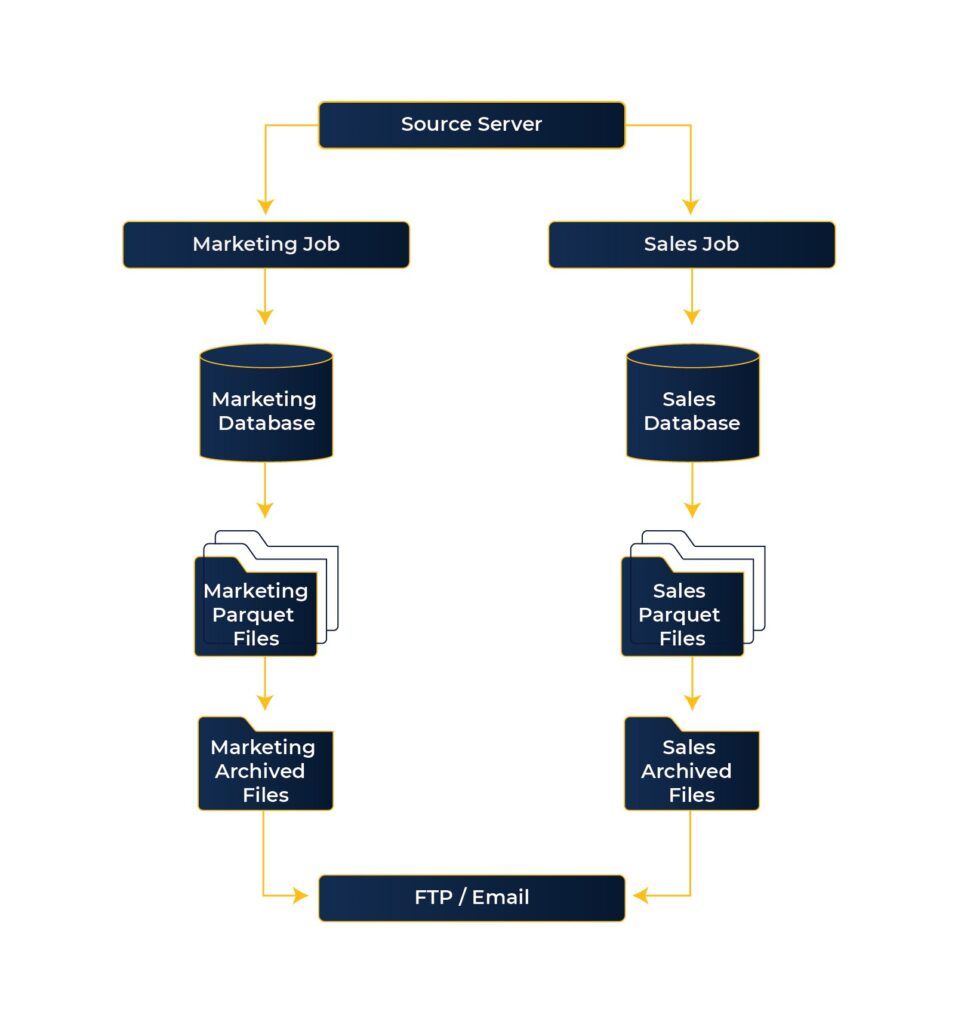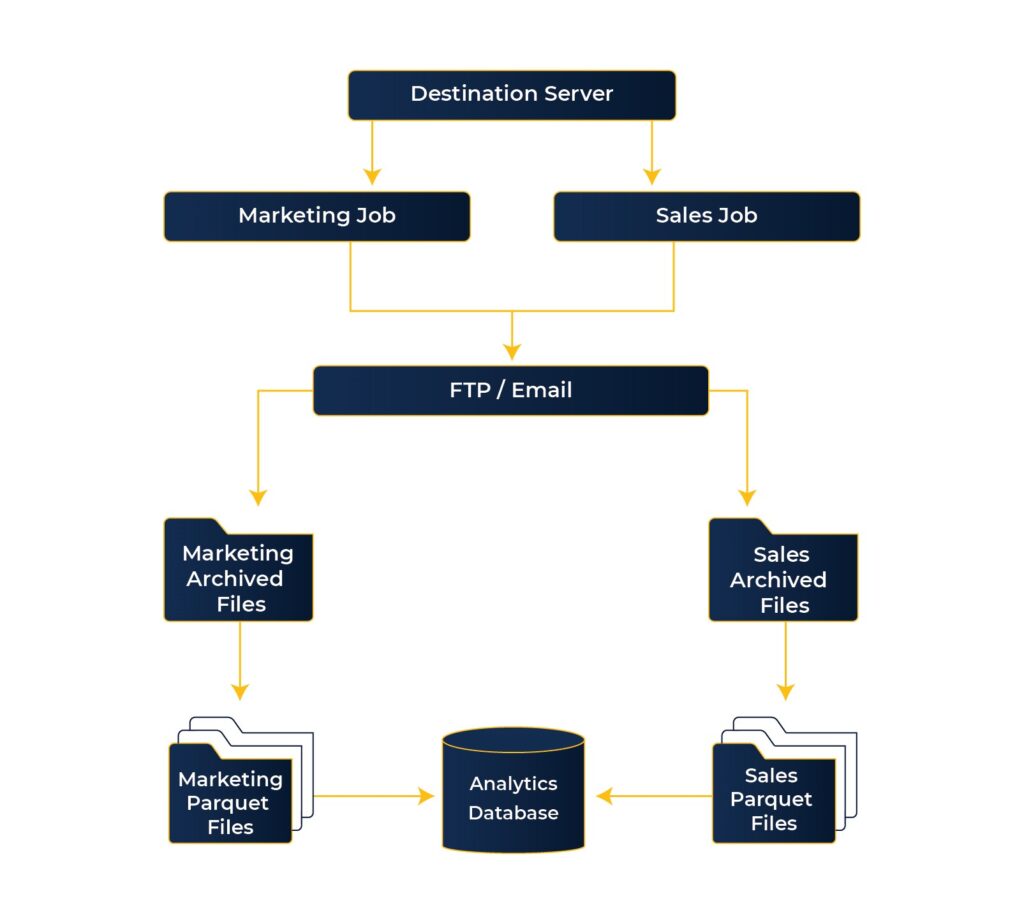Domain-specific technologies characterize the modern era. Organizations, in order to leverage the best of what our times offer, prefer to use a diverse array of tools and technologies to fuel business growth. Companies use a synergy of several database platforms to design, optimize, and automate transactional data storage. However, having multiple database platforms within an organization often becomes a hassle when you need the data in one place to perform data analytics and reporting. This is where the server to server migration utility in Python helps.
This article will provide a comprehensive guide to server data migration services. Its understanding, types, and the best practices for this migration.
What is Server Migration?
Server to server migration is a Python utility designed to automate the migration of data residing in multiple database platforms on different servers via intermediate mediums like FTP or emails in the format of Parquet files. You can use this capability to load all the necessary data into one database platform, which you can use to set up a reporting dashboard or an OLAP cube.
The feature supports data transfer between the database platforms mentioned below:
- MySQL
- Microsoft SQL
- Oracle SQL
- PostgreSQL
- Greenplum, etc.
Types of Server Data Migration

Migration of data between servers can be done through various techniques. Depending on existing hosting framework, one of the following server data migration techniques is used:
P2P Migration
Physical-to-physical (P2P) migration directly transfers data from one server to another without any virtual help, such as cloud services and external storage.
Cloud Migration
Cloud migration transitions data and applications to cloud-based platforms such as AWS, Azure, or Google Cloud to enhance scalability and accessibility.
Cloud migration can be from a physical to a cloud server or between two cloud servers.
V2V Migration
V2V migration (Virtual-to-Virtual) is relevant in modern IT setups where virtualization is prevalent. V2V transfers files from one virtual location to another. Platform-specific tools help with this type of migration.
Application Migration
This method involves relocating software applications from one server to another. It is usually opted for infrastructure upgrades or to shift to cloud-based environments.
P2V Migration
In P2V (Physical-to-Virtual) migration, the workload is transferred from physical servers to virtual environments. This approach is common when organizations use virtualisation technologies to modernize their infrastructure.
Apart from these, there are other types of server data migration, such as database migration, operating system migration, and hybrid migration.
Best Approach to Server Data Migration
Here is the best way to handle the migration of servers:
Pre-Migration Planning
Prior to beginning the migration of servers, it is essential to conduct a thorough pre-migration assessment. This includes:
- Identifying the data to be migrated
- Evaluating resource allocation
- Assessing risks
Documenting all configurations and dependencies ensures a smooth transition.
Step-by-Step Server Data Migration Process
The following steps outline a comprehensive migration process to ensure data integrity and minimal downtime:
Extract Data from Source Servers: Extract the data from source databases based on the configurations provided.
Save Data in Parquet Format Files: Save the extracted data in Parquet files, ensuring efficient storage.
Archive Parquet Files: Archive these files for added security and portability.
Upload Archived Files: Use FTP or SMTP hosts to upload these files securely.
Download and Unarchive Files at Destination: Download the files to the destination server and unarchive them to individual Parquet files.
Read and Dump Data into the Destination Server: Parse the files and import data into the destination databases.
Handling Migration During Active Use
For organizations that cannot afford downtime, consider phased server migration approaches or replication techniques. Incremental backups and real-time data synchronization can ensure uninterrupted operations.
Utilizing Specialized Migration Tools
For a faster server data migration process, consider using tools such as Microsoft’s Storage Migration Service or other third-party solutions. These tools automate tasks, minimize errors, and ensure compliance with security protocols.
Post-Migration Testing and Validation
Once the server data migration is complete, conduct rigorous testing to validate the destination servers’ data integrity, performance, and functionality. Address any discrepancies immediately to avoid operational disruptions.
Understanding Data Migration Architecture
Let’s dive deep into the details of how this utility extracts, migrates and loads the data between different servers. The jobs configured on the source server for different modules perform the below-mentioned steps for data migration:
- Extract the data from source databases based on the configurations provided.
- Save the data in Parquet format files.
- Archive the Parquet files.
- Upload the archived files on an FTP host or an SMPT host.
The diagram below illustrates the data movement flow from a source server to an FTP/SMTP host.

Destination server jobs perform exactly the reverse of the flow mentioned above.
- Download the archived files from FTP.
- Unarchive the files to individual Parquet files.
- Read the Parquet files.
- Dump the data in the destination server databases.
The data migration architecture diagram below illustrates the data movement flow from an FTP/SMTP host to the destination server.

How Secure is this Data Transfer?
Companies need to be confident that they have strong data security and can protect against data loss, unauthorized access, and data breaches. Poor data security often results in critical business information being lost or stolen. Not only this, but it also leads to mediocre customer experience, eventually damaging your business reputation and causing you a loss.
This server to serve data migration strategies Python capability utilizes Parquet files to ensure data security and integrity. A modular encryption mechanism that encrypts and authenticates the file data and metadata protects the Parquet files containing sensitive information.
When writing a Parquet file, a random data encryption key (DEK) is generated for each encrypted column and the footer. These keys are used to encrypt the data and the metadata modules in the Parquet file.
Utility Setup
The steps for setting this utility up are pretty straightforward. Here’s what you need to do:
- Download the utility setup.
- Update the database and file configurations.
- Schedule the utility on the desired frequency.
Conclusion
Server to server migration between multiple database platforms has become the need of many organizations utilizing their data to improve their businesses. However, these data migrations between servers are often tricky and time-consuming.
But you need not worry. This utility helps you execute data migrations and SharePoint migration efficiently while saving you a lot of time and repetitive efforts.
If you need to set up the server-to-server data migration utility or require support from Xavor to update the utility for your specific use case, please feel free to contact us at [email protected]. Xavor has a highly qualified data team that constantly works on developing and maintaining such utilities to address the modern data needs of our clients.

